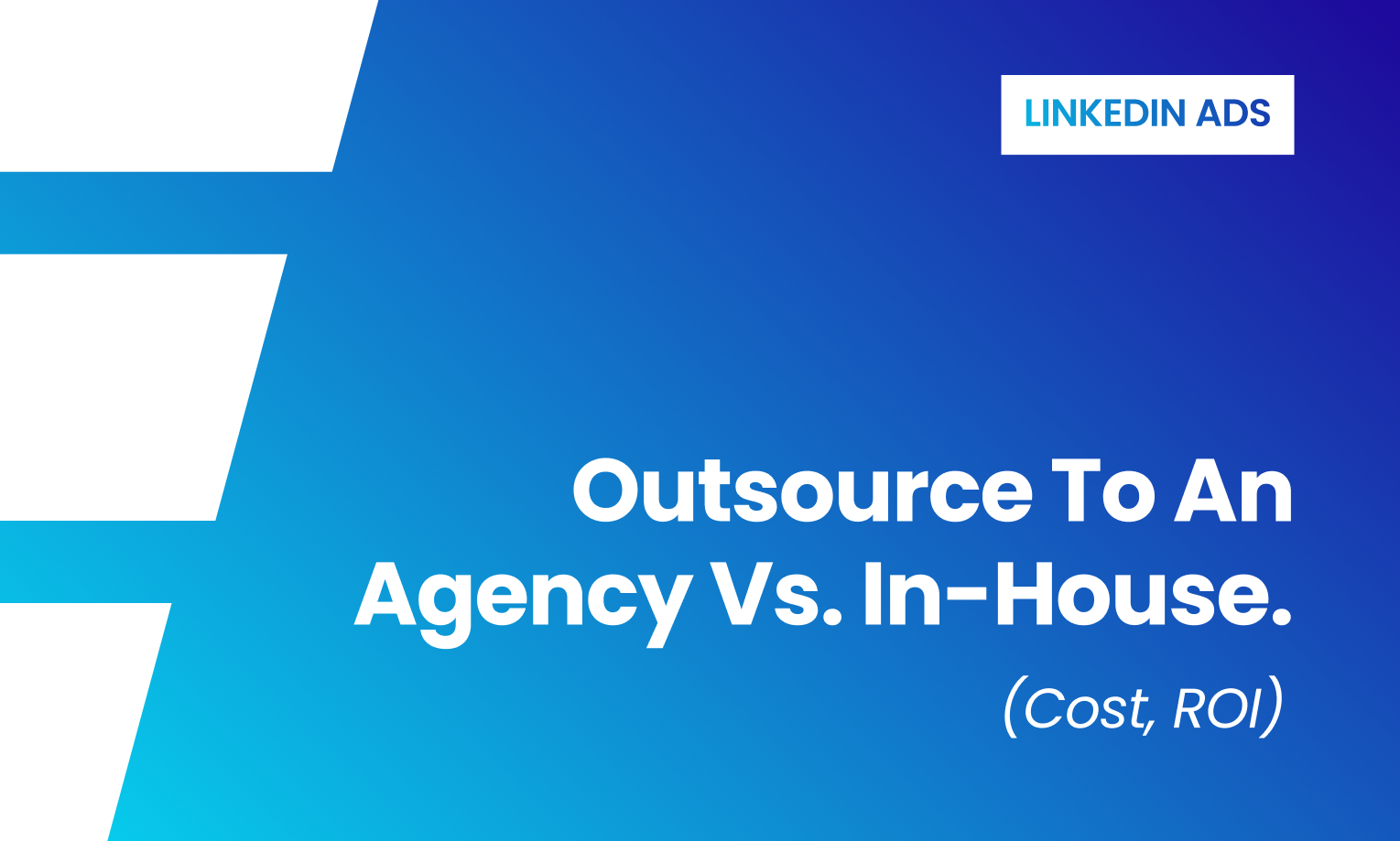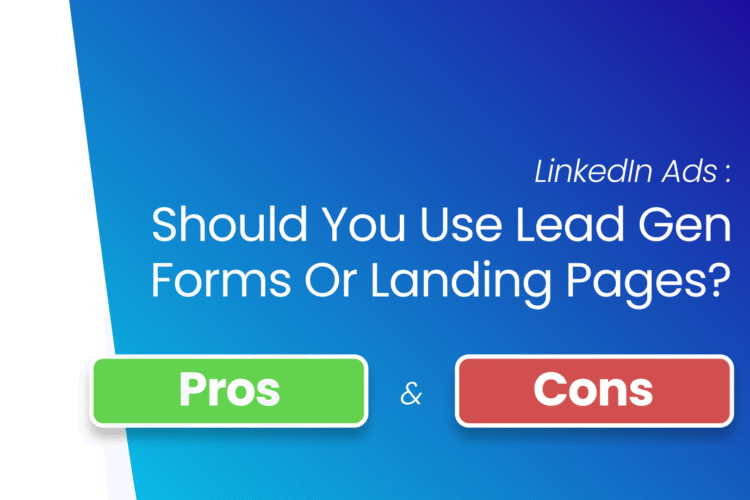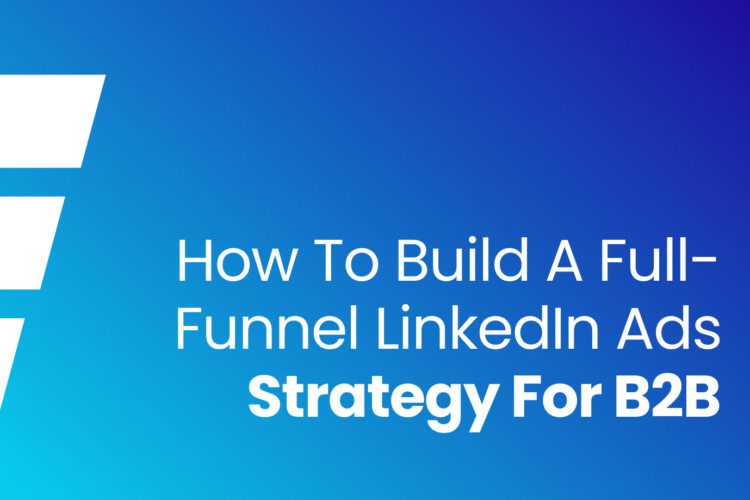
My friend, Vora, recently shared a fantastic anecdote with me. And I related that hard to this topic (LinkedIn Ads agency vs in-house team.)
(Side effect of being a LinkedIn advertising agency: We connect dots from our real-life anecdotes to LinkedIn ads ;))
Now, Vora has recently joined a gym for the first time and wants to lose weight fast. So, she started sharing her goals and concerns, in detail, with her trainer.
The trainer listened to her and told her, “See, Vora, you have paid your fees and joined my fitness program. Now achieving your health goal is my headache, not yours. You just keep doing what I ask you to do without second-guessing it. And the results will unfold in front of you.”
She told me that this dialogue from her trainer has changed something in her. She’s no longer stressed about the process because that’s not her job anymore. She’s just excited to see the results.
That’s exactly what happens when a B2B company outsources its LinkedIn ads to someone who has years of experience and expertise in this area.
But I won’t be too biased here.
In-house teams also exist for a reason.
While there are a lot of reasons to collaborate with an agency, companies that hire an in-house LinkedIn ads team aren’t fools either. And that’s what this article is all about.
Whether to hire an external LinkedIn Ads agency or do it in-house depends on a lot of factors.
In this article, we’ll get into the depths of how to figure out what’s best for your company and whether you’re ready to build an in-house team or hand over your LinkedIn ads to a domain expert.
But Why Does This Decision Matters So Much?
Whether to go with an in-house or, follow a DIY approach or hire a team is an important business decision.
Because LinkedIn Ads are not your average “turn on and see what happens” channel.
They’re 5–10x more expensive in CPMs compared to Meta or Google, which means every mistake costs real money.
So, deciding whether to outsource your LinkedIn ads or run them in-house isn’t just a matter of preference. It becomes a question of ROI efficiency, speed to market, and marketing focus.
Let’s break this down systematically.
When Do Companies Hire a LinkedIn Ads Agency?
1. When They Lack Domain Expertise
Most in-house marketers are strong at Google or Meta ads.
But LinkedIn Ads operate on a completely different logic: audience layering, bidding strategy, and offer alignment matter much more here.
B2B teams often underestimate how nuanced LinkedIn is until they burn through $10,000+ learning the hard way.
That’s when they hire agencies that live and breathe LinkedIn Ads.
“CPMs are 5–10x higher than Meta. Hence, mistakes are costly.”
A good agency already knows the benchmarks, audience types, and creative formats that work best for your ICP.
2. When They Don’t Have the Budget to Hire Internally
Hiring a skilled in-house team isn’t cheap.
To execute LinkedIn Ads effectively, you need:
- A strategist
- A paid ads manager
- A copywriter
- A creative designer
- A data analyst
That’s an entire mini-agency in itself.
For small or mid-sized B2B companies, it’s far more cost-effective to outsource this expertise to a specialized agency than to hire five different roles.
3. When They Want Quick Results
Agencies come with ready-made playbooks– they’ve already tested hundreds of campaigns across industries.
That means less trial and error for you, and faster time-to-results.
Instead of spending months experimenting, you can leverage their learnings and start optimizing from day one.
4. When They Want Peace of Mind
Founders and CMOs outsource not just for ROI and performance, but also for peace.
They want to focus on scaling their business and not worrying about the heavy tasks of LinkedIn ads management, which includes things such as:
- bid caps,
- CTRs,
- campaign attribution,
- constantly changing trends, and
- fretting over the results
They just want a readymade system and a system manager that works like a magic wand whenever they need an update on the ROI.
A trusted LinkedIn Ads partner brings clarity and structure. You don’t have to micromanage or panic about whether your ads are even reaching the right audience or performing like they should.
When Do Companies Go In-House with LinkedIn Ads?
1. When They Have the Expertise
If you already have paid social specialists who understand how LinkedIn differs from other platforms, going in-house can make sense.
They can control messaging more closely and align the campaigns deeply with brand tone and positioning.
However, remember that this approach typically works best for Series B-funded or later-stage companies with established marketing teams.
2. When They Have a Big Budget
An in-house team is a fixed cost.
If you can afford the salaries, tools, and continuous testing budget, then in-house can give you full creative control.
However, it only works if you spend at least $ 15,000–$ 20,000 per month on ads and maintain a continuous data flow to justify the team’s costs.
3. When They Want Full Control
Some brands prefer to own everything: messaging, optimization, analytics.
They don’t want to depend on external partners for approvals or reports.
That control comes at a cost. But if you’re big enough, it can help you build your own internal LinkedIn playbook that compounds over time.
4. When They Want to Write Their Own Playbook
Large enterprises or well-funded B2B startups often want to internalize the learnings and frameworks of their campaigns.
They see LinkedIn paid ads as a long-term capability, not a temporary lever.
If your vision is to create an internal “LinkedIn Center of Excellence,” then in-house makes sense.
On that note, if you want to go in-house, save your ad money with this article before you make your LinkedIn ad live:
10 Common LinkedIn Ads Mistakes That Burn Your Budget

Why Many SaaS and B2B Teams Eventually Outsource
1. Strategic Reasons
They’ve realized LinkedIn Ads ≠ Facebook Ads.
They need a predictable, professional framework, not a playground for experiments.
Outsourcing gives them access to specialists who understand:
- B2B audience layering
- Funnel structuring (ToFu → MoFu → BoFu)
- Offer design and ad sequencing
They’re not paying solely for plugging in and playing the campaigns. They’re paying for a predictable demand engine.
2. Operational Reasons
For teams of 2–5 marketers, it’s impossible to juggle everything.
An agency acts as a plug-and-play team with strategists, designers, and ad buyers ready from day one.
It saves months of training and hiring delays.
3. Performance-Driven Reasons
Most companies come to agencies after hitting a ceiling with:
- Organic content
- Cold email
- Google Ads
LinkedIn fills that “gap” between awareness and sales calls.
But to make it profitable, you need data-backed optimization, something agencies are wired for.
4. Psychological Reasons
At the end of the day, business owners want peace of mind. (Remember Vora’s story I told you at the start?)
They want someone accountable for results.
They want to know that even while they’re asleep, their campaigns are being optimized, not ignored.

How to Decide: The 3-Question Test
Before you decide, ask yourself:
- Do we have internal paid media expertise on LinkedIn specifically?
If not, the “learning tax” could easily cost you more than an agency retainer. - Can we afford to wait months for data and optimization?
If your pipeline needs quick wins, agency is the better bet. - Do we want to learn or scale?
If your goal is to learn ad ops internally, go in-house.
If your goal is to generate a qualified pipeline fast, outsource.
Real-World Example
When TheOther4, a beverage innovation consultancy, approached us, they didn’t want to burn their small marketing budget experimenting.
- They needed predictable results fast, and they wanted to position themselves as the go-to beverage innovation experts globally.
- We built them a multi-channel growth marketing engine, combining LinkedIn Ads, landing page optimization, and funnel testing.
Within months, they landed premium clients like Nestlé, P&G, and Danone.
You can check out the full case study here:
👉 How TheOther4 Landed Big Brands Like Nestlé, P&G, Danone & More with a Multi-Channel Growth Marketing Engine
Final Takeaway
If you’re a small or mid-sized B2B business, outsourcing to a specialist agency will almost always give you better ROI in the first 12–18 months.
You get access to expertise, speed, and clarity, without the fixed overhead of hiring full-time.
But once your LinkedIn ad spend scales beyond $20K/month and your team develops platform knowledge, transitioning in-house can give you tighter control and long-term cost efficiency.
👉 In short:
Outsource to grow. In-house to scale.
❓FAQs
1. Is it cheaper to hire a LinkedIn Ads agency or build an in-house team?
Hiring an agency is almost always cheaper in the short term.
An experienced agency retainer costs around $2,000–$6,000/month, while building an in-house team (strategist + copywriter + designer + analyst) can exceed $10,000–$15,000/month in salaries and tools.
For most small to mid-sized B2B companies, outsourcing delivers better ROI without the fixed overhead.
2. Can a small B2B company run LinkedIn Ads successfully in-house?
Yes, but only if your team already has LinkedIn ad expertise.
Unlike Meta or Google, LinkedIn’s cost per click and CPM are high, which means trial-and-error can get expensive.
If your internal team has limited experience with B2B targeting or funnel design, it’s safer to start with an agency before transitioning in-house later.
3. How long does it take to see results from a LinkedIn Ads agency?
Typically, 2–6 weeks after launch.
That’s because agencies already have frameworks for audience setup, ad testing, and funnel sequencing.
In contrast, an in-house team might take 3–6 months to build, test, and optimize campaigns from scratch.
4. What’s the ROI difference between agency-managed and in-house LinkedIn Ads?
Agency-managed campaigns tend to produce higher short-term ROI, because they’re optimized faster and backed by real-world data from multiple clients.
In-house setups deliver better long-term ROI but only once the team is trained, has access to historical data, and runs continuous experiments over time.
5. When should a company transition from agency to in-house LinkedIn Ads?
A good rule of thumb:
When your LinkedIn ad spend exceeds $20,000/month and your internal marketing team can handle campaign management, analytics, and creative production independently.
At that stage, bringing it in-house can save costs and give tighter creative control, but until then, agency expertise delivers the best efficiency.


